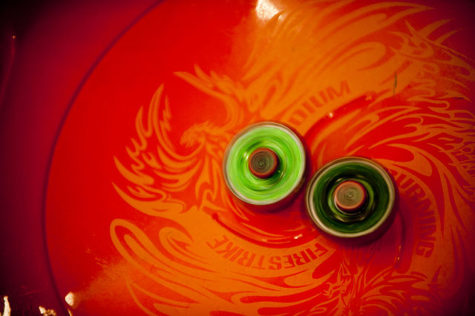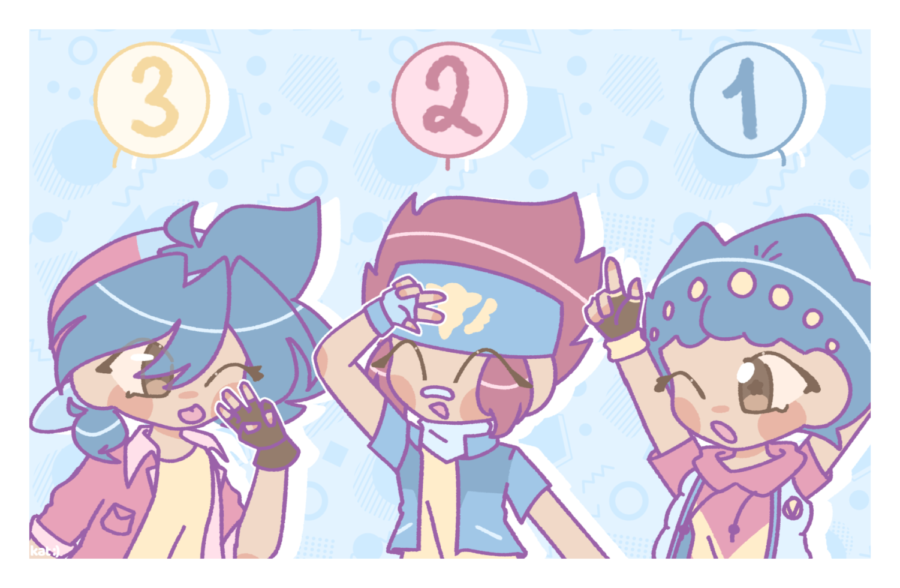Beyblade: Spinning Tops
These children could use their toys to save the world, but they would rather play.
The protagonists of the three main Beyblade sagas – Tyson Granger (left), Gingka Hagane (middle), and Valt Aoi (right) – hold three, two, and one fingers up to represent the phrase – “3, 2, 1, let it rip!” – bladers recite this phrase before playing.
Imagine a world where Rasputin uses dark magic to create a children’s toy and Moses uses a similar toy to part the Red Sea. This is the reality of the Beyblade anime.
Beyblade is a commercial anime made with the sole purpose of advertising the titular toy franchise. It is very successful, with three main seasons – each with smaller installments and two with movies – as well as three spin-offs.
The name “Beyblade” applies to both the anime and the toy it promotes, with the latter being a small top consisting of 3-4 layers. The game is played by using launchers to propel the beys, short for the physical beyblades, readying them for battle against others.
As of now, there are three sagas of Beyblade toys, each adapted into an anime season: Original or Plastic, Metal, and Burst. Before Burst, a blader – someone who plays with beyblades – could only win in a “Ring Out” Finish by pushing the opponent’s bey out of the stadium or in a “Spin” Finish by preventing the opponent’s bey from spinning. Burst introduced beyblades with intentionally removable layers; the opponent’s bey could be “burst” by force, separating the layers in a “Burst” Finish.
The game is quite simple, but the problem lies within the way the anime defies the laws of physics and logic to become more entertaining. Anime is not known for being realistic, but when the sales of a product are at stake, it is wise to stay true to the source material.
Training methods and the beybattles, the actual battles when beyblades are used, are the main culprits of this problem of defiance.
Characters in the anime will often undergo extreme and borderline unnecessary training for preparation. The most common example is constant weight wearing, which realistically leads to more soreness than strength gain.
Kai Hiwatari, the “rival” character in the Original saga’s installment, Beyblade G-Revolution, dons a weighted scarf that can shockingly crush solid concrete and metal. However, the ends of the scarf flow in the wind, suggesting that only the front is weighed. His scarf is very over-the-top, and he surprises many other characters whenever he decides to rip it off and destroy property.
Similarly, Wakiya Murasaki, one of the main characters, and Ranjiro Kiyama, the “best friend” character, sport weighted vests and cuffs in Beyblade Burst. They wear them every day, which is not healthy in the slightest because of the aforementioned soreness.
Free de la Hoya, the morally gray “Number One Blader” from Beyblade Burst Evolution, trains by attempting to move a huge boulder twice his size, claiming, “You can’t rise to the top if you don’t find your own limits and push them.” He, being an 11 year old, struggles, and is depicted yelling and sweating copiously. Lifting too much weight can cause muscle damage, which is bad for both Free. As a minor criticism, he and several other Burst characters run, which seems useless for beyblade.
One of the most extravagant examples of training comes from Kyoya Tategami, the rival in Beyblade: Metal Masters, when he willingly jumps into several tornadoes in order to “master” them, much to the dismay of his friends. Kyoya’s desire makes sense considering his bey harnesses the ability to create tornadoes, but this method is risky [EP 72].
Kyoya had trained in preparation for an upcoming battle in the World Championship against his rival and the main character, Gingka Hagane. During this battle, both characters used their special moves and sustained several injuries, and they eventually passed out due to the intensity of the battle. Other characters are worried by their passing out and urge them to rest. Yet the two did not rest.
Beybattles are meant to be the focal point of the show, so clearly they have to be entertaining. One of the ways this is achieved is through special moves accompanied by visual effects.
G-Revolution’s action-packed finale featured main character Tyson Granger and main villain Brooklyn, whose battle produced several whirlwinds that destroyed buildings and scattered the debris. Brooklyn then sprouted black angel wings and began ascending, one assumes, to Heaven. Tyson, wanting to continue their battle, floated (no wings needed) himself and his bey up to meet Brooklyn. The battle continued, with the two traversing different dimensions, which should not be happening with a supposed terrestrial and non-destructive game.
This may not seem so outlandish, considering the importance of a finale, but other battles and special moves are also quite intense. In one regular battle of G-Revolution, the bladers’ special moves combine to create large amounts of green lighting and a huge crater [EP 37].
Characters in the Metal Saga’s anime also harness powerful moves such as summoning crabs, turning the stadium into sand, and controlling gravity, probably breaking “at least one law of physics,” as Maria Gil ’23 said. These powers are, despite attempts of scientific justification in the anime, not comprehensible as something a spinning top could feasibly accomplish.
The Metal Masters installment surprisingly acknowledges this strangely destructive power through its main villain, Dr. Ziggurat. Dr. Ziggurat is fully aware of the intensity of a bey’s power and its potential, so he sensibly decides that this power should be used for something more substantial than a children’s game.
Once this repurposed energy was ready, Ziggurat decided to demonstrate it by annihilating a whole forest and making a city fly. These destructive attacks were not the best idea, but they were an effective example. Ziggurat claimed the power could end the current energy crisis, yet he planned to sell it off to the highest bidder [EP 96].
Considering the destruction that occurs when normally using beys, this seemed like an excellent alternative. However, Ziggurat was not concerned with the buyer’s intent, so the main characters had to stop him because “beyblade is for fun,” choosing personal enjoyment over world benefits.
In comparison, burst is a lot tamer, with smaller stadiums and younger characters, albeit, the damage (mostly) switches from the surrounding area to the bladers. Rival Shu Kurnei has a scar over his right eye from when anti-hero Lui Shirosagi heartlessly flung Shu’s bey at him. This was broadcast on live television and no one stopped Lui or helped Shu.
Shu has also broken his arm on more than one occasion, which should not be happening during a children’s game. Free and Ranjiro have, too, broken their arms on other occasions.
Additionally, Burst utilizes launches – which had been uniform in Original and Metal – to increase entertainment. The first unique launch was main character Valt Aoi’s Rush Launch, where his launcher is slightly angled down, allowing the delivery of a barrage of quick attacks [EP 1].
This is not very exciting, but the launches quickly become more intense; during Japan’s National Competition, Valt jumps at least 16 feet in his Runaway Launch. He should not be able to do this as an 11 year old. The show actually acknowledges how dangerous this is, as Valt injures his hands upon using them to stabilize his landing.
Three seasons afterwards, in Beyblade Burst Rise, returning main character Aiger Akabane copies the Runaway Launch, although he decides to be “so incredibly extra,” in the words of Mollie Ehrenberg ’23. He does a quick run, follows into a one-handed handstand, transitions into a high backflip, a 1080° spin mid-air, and finally launches while still suspended. 12 year olds should not be able to do this.
Although, considering how these, and all the other, bladers run, jump, kick, spin, twist, turn, throw their launchers (which they have to catch to launch), and do several more flashy moves to build-up their launches, their training by running is somewhat rationalized.
These launches are, clearly, difficult to perform in real life, as are the special moves. However, something different that translates well from anime to toy is the unique ability of each bey. Initially, the toys were made first, then adapted into the anime. Though, as the anime gained popularity, it began to create its own beys and powers that had to be cleverly incorporated into the toys.
Some of the anime’s beys hold a rare and powerful ability to “spin-steal,” where the bey can increase its own speed at the cost of its opponents’ speed. When these beys are produced, they are manufactured with rubber parts – which have shock-absorbing properties – enabling them to effectively spin-steal.
Other special features, such as a suction cup performance tip – the bottom of the bey that touches the stadium – and a 23 millimeter spin track – the piece above the performance tip – translate very well into successful powers.
In addition to these characteristics, the customizability provides another fun component; bladers can reassemble beys with new parts and experiment. [Note: Takara Tomy and Hasbro both produce Beyblades. Parts from their sets are not interchangeable.]
Moreover, sometimes special beyblades are created. A surprising collaboration between Beyblade and Hello Kitty resulted in Takara Tomy’s Astral Hello Kitty [Over Revolve’-0]. Hasbro also launches exclusive beys, and Magma Ifritor [17 Ciquex-Q-Jaggy-Q+Wave-G03] was the first one to appear in the anime, accompanied by its own original and Burst’s first prominent female blader: Ilya Mao.
The only disparity seems to be the stadiums; the anime’s stadiums are huge and made of some sturdy material, as they can be scratched and even cracked. Additionally, the anime takes creative liberties to make new stadiums. Destroyer Dome is a shockingly massive sphere that bladers go into, allowing their beys to travel in all directions. Burst Beystadium is a more challenging stadium for the Burst saga, uniquely equipped with spiked claws for increased chances of bursting.
In contrast, real stadiums are small and made of plastic. These two stadiums were some of the few manufactured for play, though they were toned down. Destroyer Dome is reasonably a lot smaller, and Burst Beystadium’s claws were replaced with rounder spikes.

Beybattles in the anime are dragged out, but actual battles are quick. The beys zoom around the stadium and are defeated relatively soon after landing. However, this speed only makes it more exhilarating.
Additionally, the intensity of the anime works in its favor by making it more entertaining. Katherine Han ’24 and Elizabeth Colon ’23 compare it to the popular ‘HunterxHunter’ and ‘Haikyuu!’ animes.
The special moves and visual effects are also quite pleasing and entertaining, mainly due to the themes of fantastical creatures, such as those from zodiacs, constellations, and mythologies.
It seems that, in choosing to establish extravagant standards in their anime, Beyblade has successfully advertised the fun and entertaining aspects of their product. Beyblades have found their way into our generation’s childhood, whether we personally played with them or simply watched our classmates play with them.
As a product of the 2000s, beyblade will remain a beloved part of many students’ childhoods. “I hope that one day I can share the same magic that these toys brought to me when I was young,” said Alex Neampong ’22.
It seems that, in choosing to establish extravagant standards in their anime, Beyblade has successfully advertised the fun and entertaining aspects of their product. Beyblades have found their way into our generation’s childhood, whether we personally played with them or simply watched our classmates play with them.
Kathy Le is an Editor-in-Chief and Chief Graphic Designer for ‘The Observatory’ yearbook, where she enjoys experimenting with playful, approachable...

